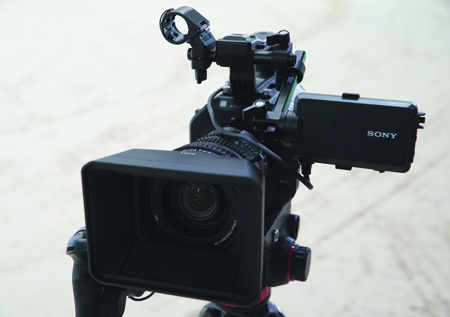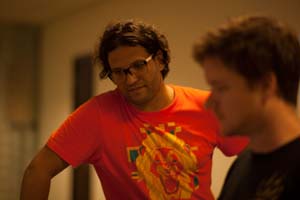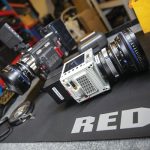Andrew Clemson, a DoP based in Dubai, tests the FS7 ll before it hits the market and gives us the lowdown.

Andrew Clemson, a DoP based in Dubai, tests the FS7 ll before it hits the market and gives us the lowdown
The FS7, I would argue, is the definitive camera in its class. It feels like its taken as much of a share of the ENG market as the EX1 and EX3 did back in their day, and the additional benefits of the large format sensor, high frame rates and cinema colour spaces make it a corporate workhorse.
I shoot a huge amount of work now on Sony cameras, both the FS7 and the absolutely miraculous A7S Mark ll (A7S II). So when Sony offered me a look at the new addition, the FS7 II, I immediately jumped at the chance.
Unlike the jumps in technology seen in other cameras, the FS7 II is essentially a tweaked version of the FS7. It is certainly not as big of a leap in tech as the A7S to A7S II, but there are still plenty of new features to warrant an updated release, especially in the hardware.
Like the FS7, this new camera has a Super 35 sensor, which records in both 1080P up to 180FPS and 4K up to 60FPS. It records to the same XQD cards and features the ever-adaptable Sony E-Mount.
The first selling point of the FS7 II over the existing camera is the implementation of in-camera BT2020 colour science. The option, also known as REC2020, is a UHD standard that can reproduce colours that cannot be shown with the older REC709 colour space.
Obviously, the FS7 can still deliver footage for display in BT2020, but it requires post processing. Plus, knowing Sonys track record for optional firmware updates, I wouldnt rule it out being offered in the FS7 down the road. But at least for now, for quick turnaround in BT2020 you would certainly feel the benefit of the FS7 II.
The ND technology in the FS7 II is something Sony has been promising since before the FS700, but supposedly it was held back until they were confident in being able to mitigate colour shift during filtration. The technology now present in the FS7 II has, however, been around for a little while now, in the cameras smaller sibling, the PXW-FS5.
Like the FS5, there are two ways to use the built-in filtration. Firstly, you can use the more traditional filter wheel to flick between predetermined strengths. Secondly, you can flip the ND (neutral density) into Variable, and use a selection dial on the camera body to smoothly transition between ND strengths.
Variable ND is attained by liquid crystal polarisers placed between the sensor and lens mount, which essentially become darker when voltage passes through them. The great part about this system, which I mentioned earlier, is that it eliminates the colour shift of traditional screw-on Variable NDs. This is because, unlike the Vari-ND (which is essentially two polarised lenses), the LCD filter incurs no polarisation.
The strength of ND in the FS7 II also offers an additional stop in filtration, going up to 1/128, over the 1/64 of the FS7.
In this region, ND is essential, and having the ability to control the filtration from behind the lens rather than swapping out traditional filters or using image polluting Vari-NDs is amazingly useful. It is great to see a large sensor camera with such an important ENG-style feature, because not all large sensor applications involve a full crew, and indeed, lots are single operator jobs. Building on top of that usefulness, the ability to have stepless filtration could potentially save footage where exposure needs to be adjusted mid-shot.
An additional feature of the electronic ND is the Auto-ND function, which automatically steps the ND up or down to control your desired exposure. Like any other function, the speed and strength of these adjustments can be calibrated in dedicated user menus, and can be quite useful. Most people will probably prefer to control the ND manually I know, as I have a deep distrust for anything labelled Auto. But there are applications where the Auto ND might shine, such as gimbal work.
The lens mount is the other big change to the FS7 II. Rather than the traditional twist and lock style of both the FS7 and most other cameras with an SLR lens compatible mount, the FS7 II employs a new design, closer to that of PL-mount cameras. It is still an E-mount, so all E-mount lenses (or adapters) will work fine, but the new mechanics involve a stationary lens and a rotating locking mechanism.
The logic behind the mount is great when dealing with cinema lenses, where traditionally you might use the PL mount. For example, when the camera is rigged with bars, a matte box and follow focus, you want the lenses to just slot in. It keeps everything snug and secure and keeps everyones head in a familiar space.
Heres where that becomes a bit odd. If using E-mount lenses in a run-and-gun or single operator situation, I can see it getting a bit frustrating. It just isn’t as easy to change lenses with one hand as it is with the twist-and- release SLR system. I found myself having to put the camera down every time I changed the E-mount lenses.
But, having said that, I shot mostly between the included 18-110mm E-mount zoom (more on that later) and a Metabones adapter for using EF glass. The Metabones negated the new locking mechanism, so it didn’t bother me that much. In this scenario, the positive lock system can only be a good thing, as any weight gets put on the adapter rather than the mount.
Another small but neat new feature is the EVF bracket. The traditional rod mount of the FS7 has been replaced with a square-style rod, which prevents the slipping which could happen with the somewhat bulky EVF loupe. Other small changes include minor tweaks such as the audio door opening down rather than side to side, and the XQD cards ejecting further out from their slots to allow easier media swaps.
The 18 -110 mm lens, available as a kit with the FS7 II or on its own, is an F4 constant aperture broadcast-style lens compatible with any E-mount S35 camera. It offers full manual control via the lens or through servo rockers on the lens itself and on the camera.
The lens is not fast, being a maximum aperture of F4, but it is sharp, offers good range and can be controlled manually or by autofocus. One thing that did bother me is that although the lens maintains focus throughout its range, it appears to lose focus and then reacquire it during crash zooms. Im not certain if this is a focus by wire side effect or perhaps just a quirk of the prototype lens I was using, but it may put off certain users.
Budget-conscious filmmakers might struggle to justify the additional $1,500 or so price tag, but for any UHD broadcast or multi-camera scenarios, that can be seen as money well spent. The Vari-ND alone is worth the bulk of that money, especially when you compare it to clunky third-party external modules, which retail north of $700 and offer neither the stability nor the neatness.
It will be interesting to see how long the original FS7 stays available for purchase. This camera feels less of a straightforward upgrade, and more of an alternative option to the previous camera. The sensor and recording options are the same, bar the addition of the BT2020 space, and a lot of people may not have an actual use for that option.
I think that ultimately, both the FS7 and FS7 II are fantastic cameras. The FS7 II is just better in terms of functionality, especially in certain scenarios. Plus, even if the FS7 is phased out, the image is fundamentally the same, so it will continue to have great value in the second-hand market, which is great for both buyers and sellers looking to move to the newer, better iteration.
Andrew Clemson is a Dubai-based cinematographer.










































































